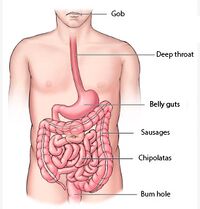Digestive system
The digestive system involves the entry of potential food (stuff that is useful or "digestible", as well as stuff that is not.
Stage One[edit]
Potential food is first taken in via the ear. The food travels passively, due to lubrication caused by earwax. An ample amount of ear wax is essential in order to maintain a healthy system. This is why poor digestion in young men aged 13-19 is extremely rare. After the food has moved through the ear, it eventually passes into the throat. The throat functions mainly due to invisible ants (Antisphanius Mela). These ants transport pieces of food into the stomach. These ants are capable of lifting up to 600,000,000 times their own body weight. If they were the size of an average human, they could lift the Empire State Building or even Micheal Moore. Smoking weed gives the ants a high, and they all immediately gather for a weed party that takes place in the brain.
Stage Two[edit]
The food eventually reaches the stomach, ready for digestion. Here, the enzymes whogivesadamnase and biologistsnamethingsinthemoststupidwaysase are secreted into the stomach via a system of pushing and shoving (Note: British digestive systems work differently, as an orderly queue is formed instead). These enzymes are secreted to start the process of digestion and their other unknown purpose is for biologists to name them with the intention of confusing unsuspecting biology students. Under no circumstances should any enzyme or other biological term attempted to be spelled, as this can be extremely harmful and is even fatal when attempted by dyslexics. The stomach then secretes alcohol to makes use of its thousands of angry leprachauns. They are used to pound the food into a pulp and then, after a while, without anything to do, begin riverdancing (Note: this is what causes stomachs to rumble). The food then passes onto the small intestine.
Stage Three[edit]
In the small intestine, food nutrients are absorbed due to thousands of minuscule elephants (elephantinal invisables) that suck all of the nutrients out of the food. The elephants themselves process the nutrients, and then these processed nutrients (or elephant faeces) are excreted for use in the human body. The rest of the food is passed on to the medium intestine (see below).
Final Stage[edit]
If the food is lucky, it escapes the medium intestine unscathed and progresses to the large intestine. Here, water is drained into the bladder through holes, just as it would escape from a bucket with a hole in it. The large intestine then adds special gases and food colourings, as well as E numbers E356 and E446 and of course aspartame. The food has now completed its journey and has becomes faeces that exit through the anus. The added materials are the reason doctors recommend that faeces should not be eaten without being thoroughly cooked.
The medium intestine[edit]
This clandestine organ exists to try to disrupt digestion and make us ill. This is because it has been ignored and has decided to take its sweet revenge on us. The medium intestine disrupts digestion either by halting or speeding up the digestive process. In extreme cases, where the medium intestine has grown too large, terminal diarrhoea can occur. The medium intestine is responsible for 50% of fatalities where food doesn't sustain life but rather ends it.

